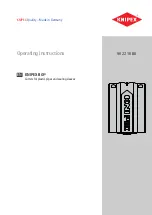
BASIC OPERATIONAL PROCEDURES
RECEIVER
5.1.
Put headphones on while being aware of the headphone cord location.
5.2.
Plug the headphone jack into the socket located on the face of the panel.
5.3.
Screw either the air probe or contact probe into the receiver port. Refer to the Typical Scanning section for optimum probe choice.
5.4.
Press down the power button to turn the unit on and watch for the LED indicator to settle to the bottom position. Turn up the volume
until you can just hear the background noise (hiss). Please Note, Increasing the volume does not increase the units detection
sensitivity. Setting the volume control too high can lead to operator fatigue.
5.5.
When using the air probe, point the probe in the direction of your free hand while lightly rubbing your forefinger and thumb together
about two feet away. The response should be the sound of sandpaper on wood. You can vary the distance and increase/decrease the
level of volume accordingly. While performing this function, become familiar with the directional sensitivity of the probe while sweeping
the probe past your fingers at various distances. If using the contact probe, adjust the sensitivity while lightly rubbing your finger along
the tip of the rod.
5.6.
The centre two buttons allow the user to listen to either a wide or narrow bandwidth.
5.7.
The receiver has an “Auto Switch Off” feature which activates after four minutes.
TRANSMITTER
5.8.
To switch on the transmitter, push and hold the power button until the green LED illuminates. This will produce a constant frequency
output (single flash).
5.9.
Pushing the button again will produce a two tone frequency output (double flash).
5.10.
Pushing the button a third time will produce a pulsing single tone frequency output (triple flash).
5.11.
Pushing the button a fourth time will produce a pulsed higher frequency output (quadruple flash).
5.12.
Pushing the button again will set the unit back to the first mode (single flash).
5.13.
If the battery is low then the LED will turn red.
5.14.
To switch off the unit, press and hold down the button until the LED switches off.
5.15.
The transmitter has an “Auto Switch Off” feature which activates after five minutes.
TYPICAL SCANNING METHODS/TIPS
The VS919 provides information in two ways: qualitative, through the ability to "hear" the signature ultrasounds produced by various types of
equipment and the ability to see the feedback level on a graduated LED indicator.
The air and contact probes are used to optimise the response depending on the type of inspection. The air probe is best used for detecting
ultrasounds associated with a pressure leak or an electrical corona, while the contact probe is best to detect the ultrasounds generated from
within a casing such as in a gear, bearing, valve or steam trap housing.
5.
OPERATING INSTRUCTIONS
Fig.2.
Fig.3.
Fig.1.
MECHANICAL MALFUNCTIONS
Fig.1. shows a typical use to inspect a potential wheel bearing problem with the VS919. In this case the air probe is used, the wheel is being
turned while listening for the sound of the bearings. The tip of the probe is kept 2-3 inches from the inspection area. Response can sometimes
be optimised by removing the wheel and using the contact probe to touch the stationary centre hub. Inner and outer bearing sounds can be
isolated by contacting the inner and outer side of the spindle The VS919 is very useful in monitoring the state of the bearings, rotors, and
armature in a motor housing such as pictured in Fig.2. Because the housing encloses the moving parts, monitoring with the receiver is best by
making contact with the outside housing with the contact probe. All sound waves conduct best through materials such as metal and the
contact probe will optimise the listening response. The contact probe is also used for investigating fuel injectors in the same manner. Touch
the tip of the metal probe to the surface area being tested.
ELECTRICAL CORONA DISCHARGE
The VS919 can detect electrical coronas due to insulation breakdown or other problems.
Fig.3. shows a typical application using the VS919 to inspect possible electrical and corona
discharge associated with power switch and breaker boxes.
As with all potentially dangerous situations, use caution. Only use the air probe when
inspecting electrical conditions and keep a safe distance between the air probe tip and the
metal panel surfaces.
The receiver is highly sensitive to picking up the voltage breakdowns described The
resultant ultrasonic sound has been described as sounding like “frying bacon."
VS919 - 2 - 160306























